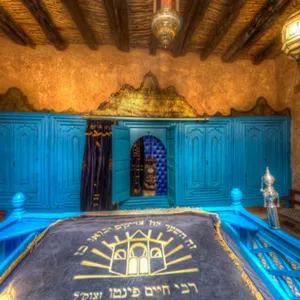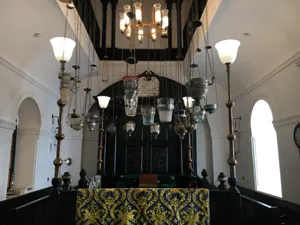From the first days of the city of Essaouira, a Jewish community was present. Around 1950, the city hosted 20,000 Jews and counted 47 synagogues.
5 Amazing Jewish Sites In Essaouira (Not To Miss!)
5. Simon Attias Synagogue - Bayt Dakira
3. Rabbi Chaim Pinto Synagogue
1. The Mellah : The Old Jewish Neighborhood
Here are the five most important Jewish sites in Essaouira.
Essaouira is not amnesiac. The city retains the places where its Jewish citizens made the reputation of Mogador.
But for Jews of Morocco, other places attract them: the Jewish sites of Mogador.
A tour to Essaouira is always a joy. The port, the Medina Of Essaouira, and the manufacturers of Thuja objects are the essential steps of this visit.
1. The Mellah: The Old Jewish Neighborhood
המלאח

In Morocco, Jews devoted themselves in general to the salt business. So we call the Jewish neighborhood Mellah, which comes from the word "salt" in Arabic.
The Mellah of Essaouira dates back to the 19th century. At that time, the neighborhood had a dark portrait. Inhabitants expansion, poverty, and the absence of hygienic conditions illustrated the Mellah.
Around 1950, this section of Essaouira with dark passages hosted 18,000 Jews (60% of the city's population).
In the Mellah, the Jewish population prepared anise-flavored fig alcohol called Mahia. The name means water of life in Arabic. The neighborhood had about forty distilleries. The liquor from the Mellah Of Essaouira went through all the southwest of Morocco.
After Morocco's independence in 1956, and the Six-Day War in 1967, almost all the Jewish population deserted the city. And the Mellah neighborhood became abandoned.
Today, the Mellah of Essaouira is one of the poorest and most marginalized neighborhoods in Essaouira.
2. The Jewish Cemetery Of Mogador
בית החיים אסווירה

There are two Jewish cemeteries in Essaouira: the old and the new. A narrow street separates them, but they are several centuries apart.
The old cemetery is very popular because of the tomb of Rabbi Haim Pinto רב חיים פינטו (1743-1845). In 1998, a mausoleum was built on his grave.
A long wall separates the old cemetery from the rocks and the sea. The last burial in this cemetery was around 1875.
The new cemetery is well organized. The graves are arranged in straight lines, in perfect order. The latest graves date from 1963.
Due to time and sea erosion, the epitaphs in the old cemetery have disappeared. On the more recent graves of the new cemetery, the inscriptions are still legible.
3. Rabbi Chaim Pinto Synagogue
בית כנסת רבי חיים פינטו

Each year, 1.500 pilgrims gather in Essaouira for the Hillula of Rabbi Chaim Pinto. The synagogue, in his name, hosts the rituals of this big event.
When Rabbi Chaim Pinto was eighteen, the Jewish community of Essaouira appointed him as a Dayan (judge) of the city.
Despite his young age, Rabbi Chaim Pinto made a distinguished reputation. His name went outside the city. Both Jews and Muslims considered him a saint. His fifth grandson, Rabbi David Pinto, narrated the miracles accomplished by his great grandfather.
At first, Rabbi Haim Pinto built his synagogue as a home. And the building served also as a place of worship and teaching of the Torah.
This Sephardic synagogue, organized vertically, is very calm and relaxing. On the ground, you will find the Rabbi's house. The little blue synagogue is on the first floor. Above all, don't skip the view from the room upstairs.
Related posts
4. Slat Lkahal Synagogue
בית כנסת צלאת הקהל

At the start of the 20th century, nearly forty synagogues existed in Essaouira. Yet, Slat Lkahal was the singular synagogue that belonged to the Jewish community as a whole. Slat Lkahal was neither a family nor an individual property.
During funeral rituals, members of the community asked for donations. The Jewish residents used the money gathered to construct this synagogue. The inauguration of Slat Lkahal was in 1850.
Also, Slat Lkahal acted as a Hebrew learning establishment for deprived kids. So the synagogue was also called the synagogue of the poor.
After the emigration of the Jews of Essaouira to Israel or Europe, the synagogue became empty. The door closed definitively, and the temple got deserted.
Today, as part of the restoration of the Mellah of Essaouira, Slat Lkahal synagogue got a second life.
The rehabilitation of Slat Lkahal started in 2010. Nowadays, all interested visitors can marvel at this historical place.
5. Simon Attias Synagogue - Bayt Dakira
בית הכנסת שמעון אטיאס - בית ד׳כִּּרה

This synagogue was constructed on a surface of 500m² and had a central patio of 40m². Shops composed the ground floor. It also included the home of the wife of Simon Attias.
On the second floor was a prayer room. Women had their own space in that prayer room.
The third floor contained the offices of the Jewish court. This court processed business and personal matters relating to the Moroccan Hebrew community.
Today, this beautiful building hosts Bayt Dakira. Bayt Dakira is a new museum and a research center for the memory of the Jews of Essaouira.
In Arabic, Bayt Dakira means the house of memory. This museum highlights the Judeo-Muslim past of Essaouira and the exceptional relations between the city inhabitants.
© 2022 Marrakech Tricks. All rights reserved | Design by Marrakech Web Design





